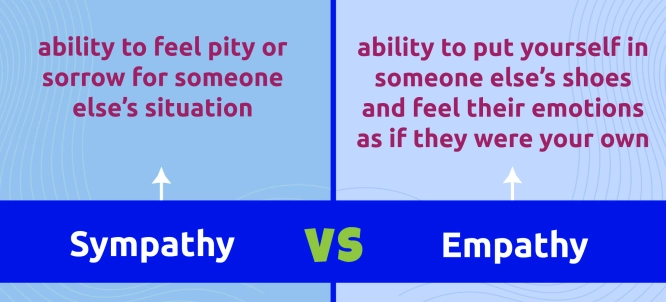by PushtoLearn
Sympathy vs Empathy
Table of Contents
Sympathy vs Empathy - Exercise and Quiz
This exercise focuses on Sympathy vs Empathy
What is "Sympathy"?
Sympathy is the ability to feel pity or sorrow for someone else’s situation. When you feel sympathy, you recognize that someone is suffering or going through a tough time, and you may feel sorry for them. However, with sympathy, you don’t actually feel the same emotions as the person who is experiencing them.
Examples of Sympathy
-
"I’m so sorry to hear about your loss." (You feel sad for someone’s loss but not the same sadness.)
-
"It’s hard to see you going through this." (You feel concerned but don’t personally experience their pain.)
-
"That sounds really tough. I hope things get better." (You understand it’s a difficult situation and feel sorry for them.)
In these examples, you recognize someone’s hardship, but you aren’t sharing their exact feelings.
|
Use |
Example Sentence |
|
Feeling sorry for someone |
"I feel sympathy for people who are struggling." |
|
Recognizing others' hardships |
"She showed sympathy by sending flowers." |
|
Offering comfort without sharing feelings |
"He sympathized with his friend’s difficulties." |

What is "Empathy"?
Empathy goes deeper than sympathy. It’s the ability to put yourself in someone else’s shoes and feel their emotions as if they were your own. When you feel empathy, you truly understand and share the emotions of another person because you try to imagine what it’s like to be in their position.
There are two types of empathy:
-
Emotional empathy: Feeling what someone else feels.
-
Cognitive empathy: Understanding someone else’s feelings without feeling them yourself but still seeing things from their perspective.
Examples of Empathy
-
"I know exactly how that feels. I’ve been there before." (You’ve experienced something similar, so you share their feelings.)
-
"I can only imagine how heartbreaking this must be." (You put yourself in their shoes and feel some of what they are feeling.)
-
"When she explained her problem, I really felt her sadness." (You feel the sadness along with her.)
In these examples, you connect with the other person on a deeper, more personal level, either by remembering similar experiences or by fully imagining their feelings.
|
Use |
Example Sentence |
|
Sharing another’s emotions |
"I felt empathy when my friend lost his job." |
|
Understanding on a personal level |
"She empathized with his grief after losing a parent." |
|
Connecting through shared feelings |
"He empathized with her, having gone through it himself." |
Key Differences Between Sympathy and Empathy
|
Aspect |
Sympathy |
Empathy |
|
Definition |
Feeling sorry for someone else’s pain |
Sharing and understanding someone’s feelings |
|
Connection Level |
Less personal, more distant |
Deeper, more personal connection |
|
Example Phrase |
"I’m sorry for your loss." |
"I know how much this must hurt." |
Common Errors
-
Using "sympathy" when "empathy" is more appropriate:
-
Incorrect: "I empathize with you on your loss." (if you don’t share their exact feeling)
-
Correct: "I sympathize with you on your loss."
-
Assuming empathy and sympathy mean the same thing:
-
Incorrect: "He felt empathy for the strangers on the news." (when you likely feel sympathy instead)
-
Correct: "He felt sympathy for the strangers on the news."
Everyday Usage Tips
-
Use sympathy if you want to show concern but do not feel the other person’s emotions yourself.
-
Use empathy if you can imagine or understand exactly what they’re feeling because you have shared similar emotions or experiences.
FAQs
Is empathy stronger than sympathy?
Yes, empathy usually means a deeper emotional connection because you feel what the other person feels, while sympathy is more about feeling sorry for someone.
Can you feel both sympathy and empathy at the same time?
Yes, it’s possible to feel both. You might feel sympathy for someone’s situation but also try to empathize by imagining how they must feel.
Can empathy be learned?
Yes, you can practice empathy by actively listening to others, asking questions, and trying to imagine yourself in their position.
What’s an example of sympathy in everyday life?
Sending a "Get Well Soon" card to someone who is sick is an act of sympathy.
What’s an example of empathy in everyday life?
When a friend is going through a breakup and you listen, remembering your own similar experience, you are showing empathy by relating personally to their emotions.

